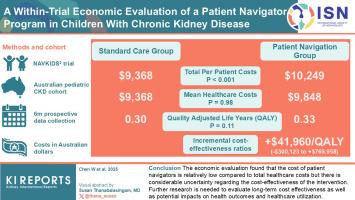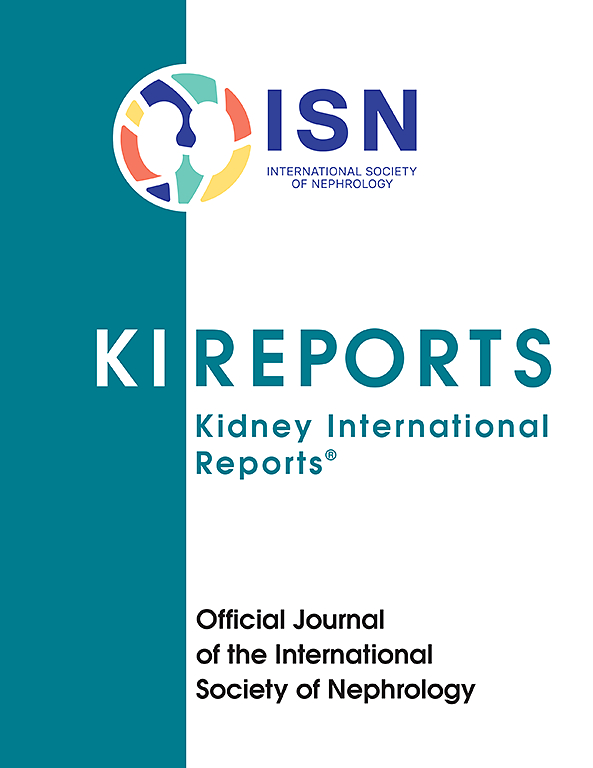儿童CKD患者导航员项目的试验内经济评价
IF 5.7
2区 医学
Q1 UROLOGY & NEPHROLOGY
引用次数: 0
摘要
NAVKIDS2试验是一项针对澳大利亚患有慢性肾脏疾病(CKD)的儿童及其照顾者的患者导航项目。我们进行了一项试验内经济评估,以描述与标准护理相比,患者导航的成本效益。方法从卫生保健资助者的角度前瞻性地收集6个月内的成本和资源利用数据。费用以澳元计算。从0 ~ 6个月收集生活质量(QoL)数据。增量成本效益比(ICERs)报告为获得的额外成本/质量调整寿命年(QALYs)。结果在6个月的时间里,患者导航组的每位患者总费用高于标准护理组(分别为10,249美元和9368美元;P < 0.001)。两组患者的平均医疗费用差异无统计学意义(分别为9848美元和9368美元,P = 0.98);然而,干预组的患者导航员每人需要额外支付1075美元。患者导航组和标准护理组6个月的总质量年无显著差异(分别为0.33 vs 0.30; P = 0.11)。与常规护理相比,干预组的ICER为41,960美元/QALY获得了宽95%置信区间(CI)(- 300,123美元至+ 769,958美元),表明存在很大的不确定性。结论经济评价发现,患者导航员成本相对于医疗总成本较低;然而,干预措施的成本效益存在相当大的不确定性。需要进一步的研究来评估长期成本效益以及对健康结果和卫生保健利用的潜在影响。本文章由计算机程序翻译,如有差异,请以英文原文为准。

A Within-Trial Economic Evaluation of a Patient Navigator Program in Children With CKD
Introduction
The NAVKIDS2 trial was a patient navigation program for children and their caregivers living with chronic kidney disease (CKD) in Australia. We conducted a within-trial economic evaluation to describe the cost-effectiveness of patient navigation compared with standard care.
Methods
Cost and resource utilization data were prospectively collected over 6 months, from a health care funder perspective. Costs were reported in Australian dollars. Quality-of-life (QoL) data were collected from 0 to 6 months. Incremental cost-effectiveness ratios (ICERs) were reported as the additional cost/quality-adjusted life years (QALYs) gained.
Results
Over the 6-month period, total per-patient costs were higher in the patient navigation group than in those in the standard care group ($10,249 vs. $9368, respectively; P < 0.001). There was no significant difference in mean health care costs between the 2 groups ($9848 vs. $9368, respectively, P = 0.98); however, the intervention group incurred an additional cost of $1075/person for the patient navigator. There was no significant difference in total QALYs over 6 months between patient navigation and standard care groups (0.33 vs. 0.30, respectively; P = 0.11). The ICER for the intervention group compared with usual care was $41,960/QALY gained with a wide 95% confidence interval (CI) (−$300,123 to +$769,958), indicating substantial uncertainty.
Conclusion
The economic evaluation found that the cost of patient navigators is relatively low compared with total health care costs; however, there is considerable uncertainty regarding the cost-effectiveness of the intervention. Further research is needed to evaluate long-term cost-effectiveness as well as potential impacts on health outcomes and health care utilization.
求助全文
通过发布文献求助,成功后即可免费获取论文全文。
去求助
来源期刊

Kidney International Reports
Medicine-Nephrology
CiteScore
7.70
自引率
3.30%
发文量
1578
审稿时长
8 weeks
期刊介绍:
Kidney International Reports, an official journal of the International Society of Nephrology, is a peer-reviewed, open access journal devoted to the publication of leading research and developments related to kidney disease. With the primary aim of contributing to improved care of patients with kidney disease, the journal will publish original clinical and select translational articles and educational content related to the pathogenesis, evaluation and management of acute and chronic kidney disease, end stage renal disease (including transplantation), acid-base, fluid and electrolyte disturbances and hypertension. Of particular interest are submissions related to clinical trials, epidemiology, systematic reviews (including meta-analyses) and outcomes research. The journal will also provide a platform for wider dissemination of national and regional guidelines as well as consensus meeting reports.
 求助内容:
求助内容: 应助结果提醒方式:
应助结果提醒方式:


